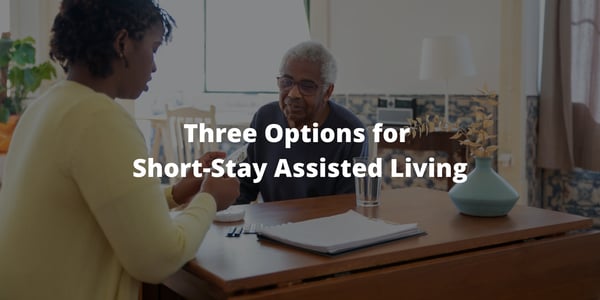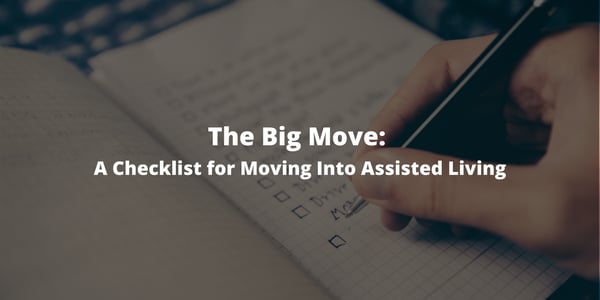A common perception of senior living is that it is an irreversible step in one's life journey....
The 9 Questions to Match You to Your Perfect Senior Living Facility
You've been thinking a lot about it for a long time. Maybe years. Is it time for the big leap of faith? Is it time to move out of your house into a senior living arrangement?
This can be one of the most challenging decisions of your life. There are so many options. It's difficult to know where to start. Here are nine questions that may provide some perspective in the face of this difficult choice.
9 Questions
-
How Do I Know I'm Ready?
It's probably been on your mind for some time. Perhaps you are tired of taking care of a house that now feels too big for your needs. Maintenance of a house and yard takes a lot of time, money, and energy. Your goal in moving to a new home would be to reduce your day-to-day upkeep responsibilities.
Perhaps you've had a scare from an accident—accidents in the home rank as a top concern for people over 55. For example, over 2.7 million older people are treated for falls annually, making this the most fatal accident for people over 65. Another risk for older adults is fire caused by smoking, heating appliances, or cooking. People between 65 and 74 are two times more likely to die in a fire than younger age groups, and the risk continues to increase with age.
Health concerns may also be driving thoughts of moving to senior living. Being closer to professional help in a health crisis could mean the difference between life and death in extreme circumstances. Even for less acute illnesses, being able to count on assistance when needed can bring peace of mind.
One senior living option that does not require a move is home healthcare. Healthcare professionals come to your home to deliver assistance and direct health services. While this is a popular alternative for those who want to stay in their home, it tends to be one of the more expensive options
-
How Should My Family Be Involved?
Involving family in the senior living decision is crucial. While typically it's your decision, depending on your health status, family members can help with the decision process. For example, they may aid in evaluating living arrangements or discussing finances.
It could be that your family is encouraging you to consider senior living. Many older adults resist such a conversation. They may resent having their family so involved in their affairs. It's important to remember our family usually has our best interests at heart. Take time to carefully consider what they are saying because you may be avoiding the subject out of fear. Giving in to that fear could put you in an unsafe situation and negatively impact your quality of life.
-
Who Else Should Be Involved?
Since this represents one of the most meaningful decisions in your life, it's a good idea to get feedback from trusted advisors. Finances are a critical factor in your transition to senior living. Your financial situation will dictate the list of options you can reasonably consider. Your banker, financial planner, or other money experts you rely on can provide invaluable information about the economic impacts of your decision.
A psychologist or clergy member can help you work through the emotional aspects of making a move. The emotional angle often gets ignored during the decision process. This is ironic since you are considering moving to new surroundings after living a particular lifestyle for decades. The stresses of making such a big move are liable to be significant. Making rational choices will be enhanced if you have a good handle on the psychological effects of the transition.
-
What are the Options for Senior Living?
The type of senior living situation you choose depends primarily on your health status. The continuum of communities from best health to worst health is:
-
Active Adults/Independent Living – For adults 55+ who need no help. Facilities may be detached homes, townhomes, or apartments/condos.
-
Assisted Living – For people who need some help with daily activities. Delivery of support is handled by qualified professionals. Housing is often apartment-style units. See the full assisted living facility checklist here.
-
Memory Care – For people with cognitive deficiencies. Often these are apartment-style units or rooms with added security to prevent residents from leaving the premises unsupervised.
-
Skilled Nursing – For people who need around-the-clock care.
A variation that can encompass all care levels is a Continuing Care Retirement Community (CCRC) or Life Plan Community. These facilities incorporate multiple levels of care in one location without moving residents off the campus when different levels of assistance and care are needed.
-
-
How Do I Find Senior Living Alternatives to Investigate?
After deciding what level of senior living situation fits you, the next step requires drawing up a list of prospective communities in your chosen geography. The ample information resources on the internet make this easy. Keep in mind, senior living facilities often pay to be listed on third party websites. Review multiple sources to create a well-rounded list.
With the list in hand, review the website of each facility and start narrowing down the candidates. Like any commercial enterprise, profit or nonprofit, senior living facilities are competing for your dollars. Therefore, websites emphasize the positive aspects of a facility. Larger, well-financed companies will have very flashy, impressive websites. Try to filter out the noise and use your best judgment to choose 3-5 facilities to tour.
Learn more on our Housing Resources page.
-
What Should I Be Looking for in a Senior Living Arrangement?
Prepare for your facility tours by using Cantissimo Senior Living's Assisted Living Checklist. A checklist will help you remember to ask the same questions on each tour so you can compare apples to apples
A checklist will cover the major senior living areas"-
Activities
-
Apartments
-
Building
-
Contracts
-
Dining
-
Financial
-
Location
-
Medication and Healthcare
-
Policies
-
Residents
-
Staff
Within each area, the checklist should have detailed attributes. Thoroughly familiarize yourself with the checklist before your first tour. For each area, add questions important to you and make sure these added questions get asked on each tour. Also, be prepared to take supplementary notes during each tour so no information is missed.
-
-
How Do I Make the Final Choice?
Once all the tours are completed and checklists filled in, it's time to do the analysis. It is important to compare all checklists and notes so every aspect can be rationally considered. This is especially important when you "fall in love" with a particular facility. Sometimes crucial information can be overlooked in the heat of the moment. A fair, fact-based comparison is more likely to lead to a satisfying decision.
That being said, it is often the intangibles that tip the scale in the end. The facility needs to line up, consciously and unconsciously, with your emotional, physical, social, intellectual, and spiritual preferences. If you don't like the "feel" of the place, then that may outscore many factual aspects in the final decision.
-
How Should I Plan the Transition to Senior Living?
Now it's time to plan the transition. Planning must be done on two levels: physical and emotional. On the physical level, it's primarily deciding what to do with your "stuff". Despite their best intentions, most people underestimate how many possessions they have. The prospect of sorting through all of it is virtually paralyzing. Here are some tips to help with downsizing from the website mymove.com.
-
Start early - Allow plenty of time because the process will take longer than expected.
-
Start small – Avoid starting in a big room like the kitchen. Start with a smaller space like a linen closet and work your way up to bigger rooms.
-
Eliminate rooms you won't have in your new home – Consider the new floor plan. You ultimately won't be happy if you try to jam a houseful of stuff into a smaller space.
-
Only make Yes or No piles — no Maybes - If you use something regularly, keep it. Get rid of duplicates. Avoid keeping something "just in case". You can strategically replace things you wish you still had. However, the vast majority of the No pile deserved to go.
-
Don't be afraid to sell things yourself – Yard sales, E-Bay, Craigslist or other websites are all ways to turn your extra items into cash.
-
Use a downsizing company – For a fee, you can avoid a lot of headaches and let experts do the job. They often have consignment outlets for more valuable items, which may reduce your cash outlay.
Downsizing can drive strong emotions. The entire transition experience falls into the category of what author Judith Viorst called a "necessary loss". It's natural to take a break every so often to cry about what you're giving up. Talk to family and friends about your feelings. See a counselor or clergy person to help you over the hump. In the end, focusing on the positive while acknowledging the sadness may make for a smoother transition.
-
-
What Happens When I Move In?
Finally, the big day arrives! If emotions weren't at a high pitch before, they are now. Enlist the help of family and friends on moving day. Their familiar faces will help get you through this sad and scary time.
You will probably be exhausted at the end of the day, so plan to allow plenty of rest after the move-in. The staff at your new home are experienced in helping new residents acclimate to their new surroundings. Senior living professionals say that it sometimes takes 4-6 weeks for a new resident to feel "at home". Visits by friends and family can help. Ultimately, the new environment will feel more comfortable as you adjust to your new normal.
Visit our Long-term Care Resources page for more helpful content about planning for care!






